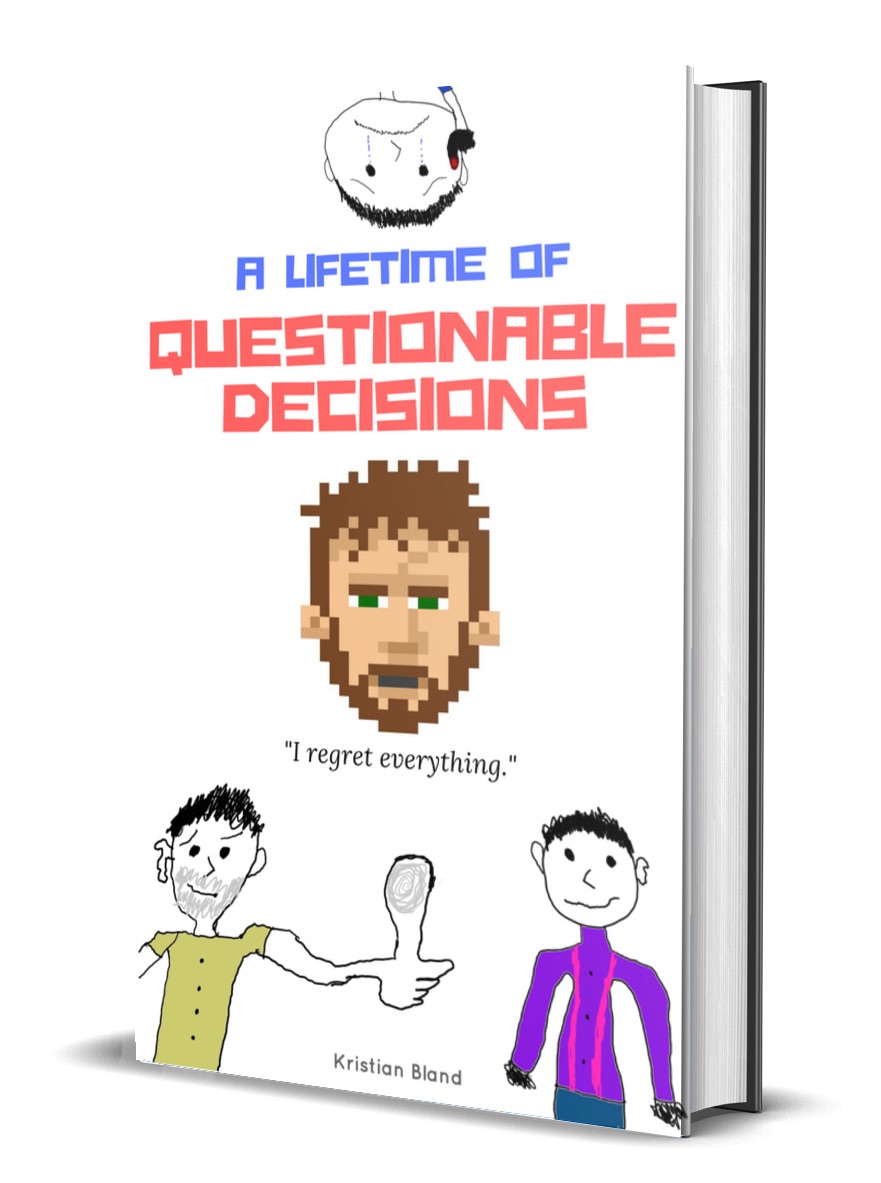Posted on February 10, 2010
The Incredible, Inedible Egg
 Earlier this month, Brittany and I were almost killed by rancid chicken menstruations. Ok, maybe rancid is a bit too strong of a word, but using a term like “bad eggs” to describe what we ate late one night as a midnight breakfast doesn’t come anywhere near to balancing out the digestive misery that soon followed. The eggs themselves looked fine, they didn’t smell bad and, since I throw enough spices into my scrambled eggs to take down either a large cocker spaniel or small rhinoceros, they didn’t even taste bad. However, shortly after finishing our delicious breakfast-for-dinner, the wife and I spent the rest of the night attempting to battle the unseen eldritch forces of a gastrointestinal Dunwich Horror as we passed each other in the hallway, going to and coming from the bathroom – or, as it came to be known on that fateful night, the Necronomiconal gateway to the Dungeon Dimensions. It wasn’t pretty.
Earlier this month, Brittany and I were almost killed by rancid chicken menstruations. Ok, maybe rancid is a bit too strong of a word, but using a term like “bad eggs” to describe what we ate late one night as a midnight breakfast doesn’t come anywhere near to balancing out the digestive misery that soon followed. The eggs themselves looked fine, they didn’t smell bad and, since I throw enough spices into my scrambled eggs to take down either a large cocker spaniel or small rhinoceros, they didn’t even taste bad. However, shortly after finishing our delicious breakfast-for-dinner, the wife and I spent the rest of the night attempting to battle the unseen eldritch forces of a gastrointestinal Dunwich Horror as we passed each other in the hallway, going to and coming from the bathroom – or, as it came to be known on that fateful night, the Necronomiconal gateway to the Dungeon Dimensions. It wasn’t pretty.
Of course, we survived. We were miserable and exhausted, but we survived. It wasn’t until the next day that we were able to confidently finger the eggs as the culprits behind our digestive misfortune, though. At first, we thought it might be the bacon, as we recently switched to a brand of the hickory smoked piggy goodness produced locally by the Zummo Meat Company. Much to my delight, however, we soon learned that the very delicious, very fresh bacon was not to blame. Instead, after inspecting the carton of organic large brown eggs from free range, free roaming chickens that Brittany had purchased the night before, it became all too clear just what had happened. We bought the carton on January 30th and cracked the first eggs on the 31st, but what neither of us knew at the time, of course, was that the eggs were well past their Sell By date at that point. About two and a half weeks past, to be more exact. It turns out that, stamped right there on the end of the carton was the phrase: Sell By Jan 13 10. I’m not sure how long eggs are supposed to remain fresh and safe to eat after their Sell By date, but I’m willing to wager that the amazing, edible egg goes bad sometime before two weeks later. Ours did, at any rate.
Amazingly enough, this is not the end to the story. After recovering from our brief excursion into the hideous realm of Salmonellaville, I made my way back to the store from whence the wretched things had come a few days later on February 3rd and found that, not only were there still plenty of cartons labeled with the same Sell By date of January 13th still stocked in the cooler, there were even a  couple of cartons stamped with a date of December 23rd! The store in question is this Kroger franchise located in my charming hometown of Beaumont, Texas. I snapped a quick photo with my cell phone for posterity, although I could fit only one of the stacks of expired egg cartons into frame and maintain enough clarity to make out the dates. There were more. I was incensed and outraged, naturally, but I’m always incensed and outraged about something. I fought back to urge to yell at a manager, which I attribute to Brittany’s calming influence. She says I tend to “make a scene” – whatever that means. There are a lot of reasons why I always advocate shopping from local stores rather than national chains, and this is just one more for the list. Local stores can’t get away with practices like this, or else they could lose their entire business in one swift lawsuit. National chains, on the other hand, have pockets deep enough that they simply don’t care.
couple of cartons stamped with a date of December 23rd! The store in question is this Kroger franchise located in my charming hometown of Beaumont, Texas. I snapped a quick photo with my cell phone for posterity, although I could fit only one of the stacks of expired egg cartons into frame and maintain enough clarity to make out the dates. There were more. I was incensed and outraged, naturally, but I’m always incensed and outraged about something. I fought back to urge to yell at a manager, which I attribute to Brittany’s calming influence. She says I tend to “make a scene” – whatever that means. There are a lot of reasons why I always advocate shopping from local stores rather than national chains, and this is just one more for the list. Local stores can’t get away with practices like this, or else they could lose their entire business in one swift lawsuit. National chains, on the other hand, have pockets deep enough that they simply don’t care.
So, instead of making myself an angry nuisance at my local Kroger, I thought I would direct my attention here on the blog, where I can not only advise people, once again, to shop locally, but to also caution everyone to just be very cautious about those expiration dates in general. Then again, sometimes vigilance is not enough. For example, I found this story (linked to from a local blog), about a Sam’s Club in Lubbock, Texas that has been engaging in the insidious practice of re-labeling expiration dates. Apparently, the Health Department believes that permitting a store to artificially extend a product’s shelf life via the enthusiastic application of new stickers is a perfectly acceptable thing to do, so stores are allowed to re-label expiration dates at their own discretion. However, the rule is that the new date must be placed alongside the original date, presumably to alert the customer that they are buying old product. This particular Sam’s Club doesn’t seem to care about that niggling little caveat though, because they’ve simply been placing new stickers on top of the old ones and misleading customers into thinking they’re buying fresh products. The store claims that, as long as the food is cooked properly, it will be safe to eat even weeks after the original expiration date. Yeah, I’m sure it is.
The problem with our food supply is that nobody seems to understand that our food supply itself is a problem. The food lobbyists have successfully convinced our legislators that lax safety standards are fine and, taking things a step further, have somehow managed to shift the onus of responsibility onto the consumer, rather than the producer. ‘Sure’, the transnational food corporations seem say, ‘our meat is probably extensively contaminated by feces, but as long as you follow the rules about  cooking it, the excrement in your food shouldn’t make you sick.’ Sadly, they’re mostly right. However, just because I can kill the e. coli bacteria swimming in the meat I buy from the store by heating it to 160 degrees Fahrenheit doesn’t mean that I’m comfortable with the idea of eating a cow poop hamburger. The Frankensteinian concoction of assorted cow parts from assorted cows from assorted locations known as Ground Beef is, of course, the most infamous for harboring all kinds of nasty bacteria, most notably Escherichia coli. The sad thing is that all of this contamination is mostly preventable – except that taking proper preventative measures tends to too strongly impact the corporation’s bottom line. It’s cheaper to deal with lawsuits (and point the responsibility for not dealing with contamination at the customer) rather than take steps to provide us with safe and healthy food, so the companies simply don’t do it – and it’s killing us.
cooking it, the excrement in your food shouldn’t make you sick.’ Sadly, they’re mostly right. However, just because I can kill the e. coli bacteria swimming in the meat I buy from the store by heating it to 160 degrees Fahrenheit doesn’t mean that I’m comfortable with the idea of eating a cow poop hamburger. The Frankensteinian concoction of assorted cow parts from assorted cows from assorted locations known as Ground Beef is, of course, the most infamous for harboring all kinds of nasty bacteria, most notably Escherichia coli. The sad thing is that all of this contamination is mostly preventable – except that taking proper preventative measures tends to too strongly impact the corporation’s bottom line. It’s cheaper to deal with lawsuits (and point the responsibility for not dealing with contamination at the customer) rather than take steps to provide us with safe and healthy food, so the companies simply don’t do it – and it’s killing us.
The image projected by the food companies concerning where our food comes from is one of agrarian wholesomeness, with pictures of quaint pastoral farms surrounded by green fields and wandering livestock, but nothing could be further from the truth. In reality, the demands of modern society (of which the fast food culture shoulders most of the blame) have necessitated the growth of the Factory Farm. In these so-called farms, there are no open fields with scattered livestock. There is no happy farmer sitting in the barn and milking cows while the rest of his family harvests eggs by hand from the chicken coop. Rather, there are closed off, non-descript buildings housing hundreds or thousands of chickens either crammed into tiny cages or allowed to “roam” within the confined floorspace alongside the hundreds or thousands of other chickens crammed into the building. Cattle are allowed to eat grass as calves, but are then shipped off to feed farms that confine the animals and force feed them corn, which fatten the cattle faster, but which they cannot digest. Animals are loaded with antibiotics to help fight off rampant infections that spread like wildfire through the confined and unsanitary conditions, and they are injected with growth hormones and other artificial manipulations designed to augment their growth to produce a final product as quickly as possible. Then, the animals are loaded up and shipped to a slaughterhouse, where they are killed and cleaned with a severity of urgency that prevents any true cleanliness at all. Cows are slaughtered and skinned with feces coating their hides, and this easily gets into the meat. It’s an assembly line from there, butchering and packaging, then shipping the beef to market with little care or attention given to its safety.
 If some superbug does eventually come along that will kill us all, I have a pretty good idea that it’ll start in our food supply. We, as the public, trust the food companies (and governmental oversight) to provide us with safe, healthy food. (Or, at least food that isn’t contaminated by an unknown and increasingly high number of pathogens.) It should not be the consumer’s responsibility to make up for the supplier’s ineptitude or carelessness. Instead, we should be allowed to have confidence that we’re actually getting what we pay for, rather than buying into an unknown variable in a foodie version of Russian Roulette.
If some superbug does eventually come along that will kill us all, I have a pretty good idea that it’ll start in our food supply. We, as the public, trust the food companies (and governmental oversight) to provide us with safe, healthy food. (Or, at least food that isn’t contaminated by an unknown and increasingly high number of pathogens.) It should not be the consumer’s responsibility to make up for the supplier’s ineptitude or carelessness. Instead, we should be allowed to have confidence that we’re actually getting what we pay for, rather than buying into an unknown variable in a foodie version of Russian Roulette.
I’m just happy that Trey didn’t eat any of the bad eggs, and that Brittany has now started checking Sell By dates with religious fervor. But I worry about the day that comes when even taking steps to cook our meat into boot leather may not be enough to kill whatever new, antibiotic-resistant bacterium has contaminated it. The solution, naturally, is to return to the smaller, independently run farms of yesteryear. However, as a solution this is sort of a non-starter, simply because no one can be convinced that the smaller, more costly way of growing our food is viable when faced with the insatiable appetite of modern culture. I think it is, but as with most things that cost more money, it just ain’t gonna happen. Always with the short-term thinking that comes from a public demanding an immediate and cheap benefit, the famous slogan, “Always Low Prices!” is the mantra, and quality and safety be damned.
Oh well, the best I can hope to do for Trey is to shop locally and buy organic – not for the nebulous and dubious claims that organic food tastes better (because it usually doesn’t), but because it’s healthier. Free range, free roaming livestock raised on a diet appropriate for the animal (ie: grass, not corn for cattle) that are kept free from growth hormones as well as the need for super doses of antibiotics are simply safer and healthier to eat. When the cattle haven’t been standing hip-deep in animal waste for most of their adult lives, there’s a lot less chance of feces getting mixed into the beef during slaughter or the butchering and  packaging processes. Produce kept free from chemical pesticides not only keeps the outside of the food clean and safe, it also keeps the inside free from contaminates absorbed through the soil.
packaging processes. Produce kept free from chemical pesticides not only keeps the outside of the food clean and safe, it also keeps the inside free from contaminates absorbed through the soil.
In a time when swine flu had people so worried that eating bacon would kill them, it’s amazing to me that the only time the public seems to get scared enough to be provoked into action is when the threat isn’t actually real. Apparently ignorant of the fact that eating pork could never give you swine flu, people stopped buying it in such numbers that the piggy lobbyists were able to convince the media and health organizations to start calling it H1N1 instead of swine flu. That’s right, after just a few weeks of the public not buying their product, the industry reacted. Granted, it reacted with its public relations department rather than have anything to do with food safety, but it was an indication that it is possible to scare industry into at least some sort of action, merely by not buying their products. If people truly demanded safer food, then all it would take would be a brief respite from buying the toxic junk that’s shoveled onto supermarket shelves and marketed as healthy and wholesome food. After all, we are what we eat – but what we’re eating is crap. Sometimes literally.









You must be logged in to post a comment.